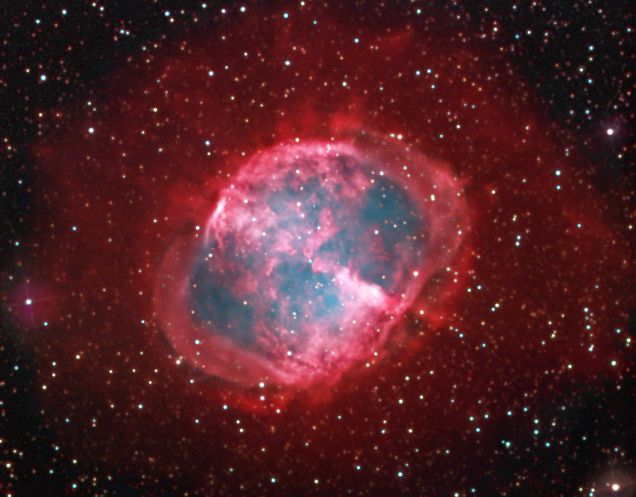
|
Credit & Copyright: Robert Gendler
Explanation:
In 1764, French astronomer
Charles
Messier sighted this gorgeous
cosmic cloud which
he
described as an oval nebula without stars.
Cataloged as M27,
it is now popularly known as the
Dumbbell
Nebula, not for its substandard academic performance but
for the elongated shape, like a bar with weights on each end, which
first
caught Messier's eye.
This deep image of the bright planetary
nebula does reveal the Dumbell's central star though, and
an array of foreground and background stars
toward the sly constellation
Vulpecula.
The picture is
a composite
that includes 8 hours of
exposure through a filter designed to record only the light
of hydrogen atoms, tracing the intricate details of
the nebula's faint outer halo
which spans light-years.
Thought to be an example of the
fate awaiting our own
Sun 5 billion years hence, the Dumbbell Nebula is
about 1,200 light-years away.
|
January February March April May June July August September October November December |
| ||||||||||||||||||||||||||||||||||||||||||||||||
NASA Web Site Statements, Warnings, and Disclaimers
NASA Official: Jay Norris. Specific rights apply.
A service of: LHEA at NASA / GSFC
& Michigan Tech. U.
Based on Astronomy Picture
Of the Day
Publications with keywords: M 27 - planetary nebula - dumbbell nebula
Publications with words: M 27 - planetary nebula - dumbbell nebula
See also:
- APOD: 2025 August 31 Á NGC 7027: The Pillow Planetary Nebula
- APOD: 2025 August 22 Á A Tale of Two Nebulae
- APOD: 2025 August 5 Á NGC 6072: A Complex Planetary Nebula from Webb
- APOD: 2025 July 29 Á A Helix Nebula Deep Field
- APOD: 2025 July 13 Á Planetary Nebula Mz3: The Ant Nebula
- APOD: 2025 June 9 Á Between Scylla and Charybdis: A Double Cosmic Discovery
- APOD: 2025 May 14 Á NGC 1360: The Robins Egg Nebula
